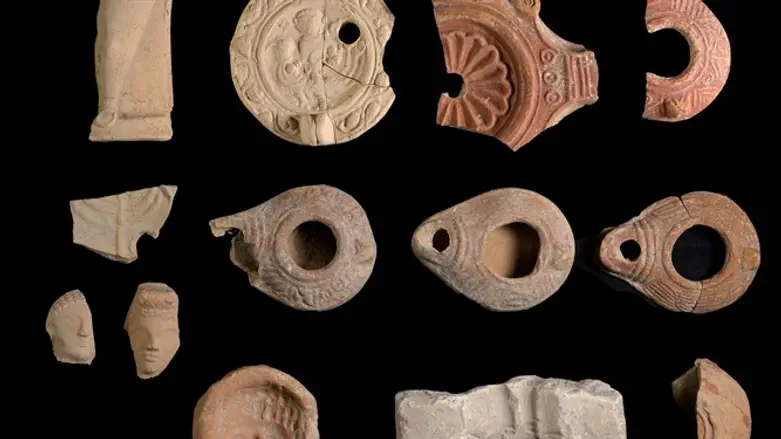
One of the largest ceramic oil-lamp workshops in Israel has been discovered by Israel Antiquities Authority excavations in Beit Shemesh.
Hundreds of ceramic oil lamps, two bearing symbols of the menorah and stone lamp molds for their production were found along with terracotta figurines which were made about 1600–1700 years ago. In the past few months, the Israel Antiquities Authority excavations aided by dozens of pre-military program students.
The large-scale archaeological excavations are being carried out prior to the establishment of a new neighborhood by the Ministry of Construction and Housing.

The discovery of the lamps, used for lighting in ancient times, surprised the archaeologists not only because of their quantity and quality, but also because it solved an archaeological mystery connected with them:
In 1934, archaeologist Dimitri Baramki, an inspector on behalf of the Department of Antiquities during the British Mandate, discovered a water cistern in the region of Beit Shemesh. On excavating the cistern, he was surprised to uncover an ancient ‘treasure’ — a huge quantity of intact oil lamps bearing animal and plant motifs and geometric designs.
The lamps are dated to the Late Roman period (third–fourth centuries CE) and became known as ‘Beit Nattif lamps’ after the name of the nearby village and have become an archaeological hallmark. Together with the lamps, Baramki recovered stone lamp molds and a wide variety of pottery figurines depicting animals, horse-riders, women, and birds.
After the British Mandate-era discovery, the location of the cistern was lost and has remained a mystery, despite all efforts to re-locate it.
“As part of the Beit Shemesh development program, we examined an area on the edge of the ancient remains of Khirbet Beit Nattif,” explain excavation directors Moran Balila, Itai Aviv, Nicolas Benenstein and Omer Shalev.
“We uncovered a water cistern that looked, at first sight, like many others in the region. But to our surprise, excavation beside the cistern began unearthing massive quantities of oil lamps, stone lamp molds and figurine fragments.” When the archaeologists entered the cistern, which was still intact, they were amazed to find that they recognized it from photos appearing in Baramki’s excavation publication. The cistern also contained items left behind by Baramki himself, including leather baskets used to extract soil and an empty metal box.
“The Beit Nattif oil-lamp cistern has been brought back to life!” the archaeologists say. “We are extremely excited, since this is not just an important archaeological discovery in its own right, but also tangible evidence of archaeological history.”
“The figurines and the motifs on the lamps from the Beit Nattif region tell the story of the Judean Hills in the period following the Bar Kokhba Revolt,” explains Benyamin Storchan of the Israel Antiquities Authority, an expert on the Beit Nattif lamps.
“From the writings of Josephus, we know that in during the Second Temple period, Beit Nattif was a regional administrative center — one of the ten principal cities under Hasmonean rule. After the failure of the Bar Kokhba Revolt and Roman takeover of the region, the local Jewish population of the Judean Hills was greatly diminished and in turn, the region was settled by pagans. The many figurines unearthed at the site attest to this. At the same time, a small number of the ceramic oil lamps area decorated with distinctively Jewish symbols such as the shofar, incense burner and seven branched menorah. The fragment tell us that Jewish life continued to exist in the Judean Hills, well after the rebellion’s failure. Obviously, the oil-lamp workshop produced these lamps in response to a continued demand in the region. During this period, Christianity also began to emerge and some of the Beit Nattif oil-lamps carry fish motifs, one of the symbols of Christianity. The sheer variety of lamps and figurines therefore proves that the local population featured a mix of pagans, Christians and Jews.”
Most of the workers in the Ramat Beit Shemesh region excavations are youths and pre-military academy students from throughout the country. Every day, the young excavators extracted dozens of oil lamps and other finds from the area around the cistern.
“The festival of Hanukkah is a wonderful opportunity to tell the public about the recovery of these oil lamps, which was the main method of lighting in ancient times,” the archaeologists say. In light of the importance of the find and its location, the Israel Antiquities Authority and the Ministry of Construction and Housing plan to preserve the site and incorporate it in a large park that will be open to the public.